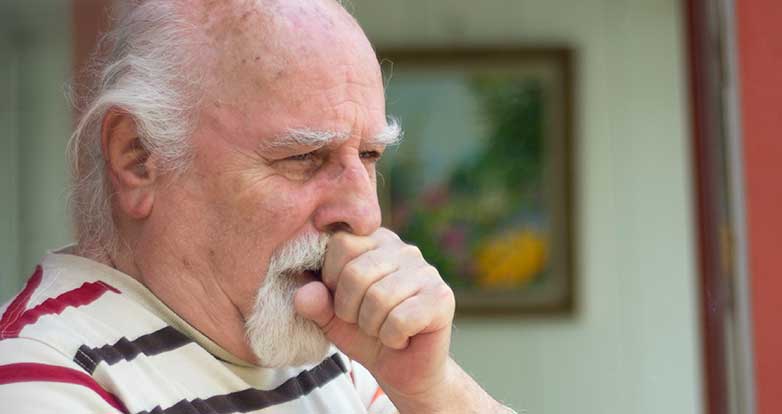COPD in a nutshell – 10 questions and answers about COPD
COPD | 02 September 2024
1. What is COPD?
COPD stands for Chronic Obstructive Pulmonary Disease that makes it difficult to breathe and causes persistent airflow obstruction.
Smokers are especially at risk for developing the condition as smoking is the primary cause for COPD. It tends to develop gradually over a period of years, with the airways becoming inflamed (swollen) and obstructed, making it harder to breathe.
There is no cure for COPD, and it is often progressive – meaning it will get worse over time. However, it may be managed with the right treatment.
2. What are the symptoms of COPD?
The symptoms of COPD develop slowly over time and people may get used to them, so many people can go for years without realising they have the condition. This is why it is so important to have any breathing issues checked out by a doctor as soon as you can.
Feeling short of breath and wheezing are two warning signs of potential COPD. Frequent chest infections are also a common symptom, and unsurprisingly, people with COPD often feel tired.
People with the condition commonly develop a chesty cough that produces a lot of mucus. As it’s a persistent cough, many people can easily mistake it for a so-called ‘smoker’s cough’.
In COPD exacerbations the symptoms, like shortness of breath, cough and sputum production, worsen over a short period (less than 2 weeks). COPD exacerbations are significant events that worsen the patient's respiratory symptoms and impact their health status and disease progression. Effective management and prevention of these exacerbations are crucial in the treatment of COPD. If a person living with COPD starts experiencing exacerbations, the regular medication should be checked with the doctor.
3. What causes COPD?
COPD develops from long-term damage caused to the lungs from inhaling irritants, such as cigarette smoke, household or outdoor air pollution or harmful chemicals at work. With COPD this damage causes breathing difficulties.
Smoking is the leading cause of COPD, although not all people with COPD have smoked, and not all smokers develop COPD.
4. What are the risk factors for COPD?
The biggest risk factor for COPD is smoking – over 70% of COPD is due to smoking in high-income countries. Quitting smoking may help slow the progression of COPD.
Exposure to gases or fumes in the workplace, heavy amounts of second-hand smoke and pollution are also risk factors, as is frequent use of a cooking fire without proper ventilation.
You’re more likely to be diagnosed with COPD if you are over 40 or had chest problems as a child. Susceptibility to COPD can run in families, so if your parents had respiratory problems, you are at higher risk.
5. What is the treatment for COPD?
Unfortunately, there is no cure for COPD. However, there are many things you can do to cope with the symptoms and help to ease everyday life.
It is very important to stop smoking if you have COPD and do smoke, as this is the best way to slow down lung damage. A healthy diet and exercise will also help to manage symptoms and make breathing easier.
There are also medications available for people living with COPD. Unfortunately, none of the current medications cure COPD, but they do reduce symptoms. COPD is mostly treated with inhaled medications. Bronchodilators are drugs, usually inhaled, that help to relax the airways. Long-acting bronchodilators are used as a regular treatment and even a combination of 2 different bronchodilators can be used by those people who have a lot of symptoms. Based on the exacerbation history and results of blood tests, the doctors may see patients benefit also from anti-inflammatory treatment (inhaled corticosteroids). It is especially important to follow the instructions, use the inhaled therapy as prescribed, and learn to use the inhaler in the correct way.
Another important part of the treatment is ‘pulmonary rehabilitation’, which involves a series of exercises, behavioural changes, and education about the disease. All physical activity has been found to be very beneficial to people living with COPD, so it is encouraged to keep active and find exercise that suits you best. With the right kind of diet and daily habits, including an active lifestyle, it is possible to have a high quality of life regardless of the severity of the condition.
In a very small number of COPD cases, surgery or a lung transplant may be considered.
6. What is a spirometry test?
If your doctor suspects COPD, they will have you perform a spirometry test. The test is a safe and routine test that measures how well the lungs are functioning. It’s used in the diagnosis of COPD and other lung conditions, such as asthma. You are asked to breathe into a tube connected to a machine called a spirometer. This measures how much and how quickly air goes in and out of the lungs.
7. Can I have both asthma and COPD?
The symptoms of COPD and asthma are very similar. Some people can have both.
With asthma, the narrowing of the airways isn’t permanent. It often comes on when triggered and the airways are irritated by something. Using regular medication often means that the lung function is normalised.
With COPD, the narrowing of the airways is permanent, so symptoms may be constant. With COPD, the regular medication will help control the symptoms, even though the damage is often permanent. That’s why it’s extremely important to quit smoking and plan the care and treatment together with the doctor.
8. What is oxygen therapy and when is it needed?
Oxygen therapy is used when the oxygen level in the blood is low. This can happen with a few COPD patients who struggle to take in enough oxygen – so it’s not suitable for everyone. Breathing in air that has a higher oxygen concentration can help to increase low oxygen levels in the blood.
Many people mistakenly think oxygen therapy helps with breathlessness. It doesn’t. Oxygen therapy helps increase the blood’s oxygen levels which helps the body, especially the heart, work effectively.
Oxygen therapy at home involves a patient breathing in air via a machine called an oxygen concentrator. The therapy needs to be used for a substantial part of the day to be effective.
It’s very important to only use an oxygen machine if the doctor has prescribed it. It can be dangerous for people who don’t need it.
9. Is it possible to live a normal life with COPD?
It is possible to live a productive and happy life with COPD. If you are diagnosed with COPD, it is likely you will need to make some changes to your life. It can mean, for instance, starting a new exercise routine to help with medication and treatment.
Getting an early diagnosis can help and many people want to do what they can to slow the progression of the disease, such as giving up smoking and taking medication properly.
10. What should I do if I suspect I have COPD?
If you suspect you have COPD you should see a doctor without delay. A chronic cough may turn out to be COPD. Your doctor will have you perform a spirometry test and a lung scan can be taken to exclude other diseases. If you are a smoker, it’s a good idea to give up smoking immediately.
The symptoms of COPD can be like other lung conditions, so the quicker you get an accurate diagnosis, the quicker you can begin effective treatment. Good management of COPD can slow the progression of the disease and can also help to ease some of the symptoms.
Reference: The Global Initiative for Chronic Obstructive Lung Disease (GOLD). Global strategy for the diagnosis, management, and prevention of COPD 2024. Available at: goldcopd.org
Photo by AdobeStock
CORP-RESP-1835
Orion Corporation is a globally operating Finnish pharmaceutical company. We develop, manufacture and market human and veterinary pharmaceuticals and active pharmaceutical ingredients. The dry powder inhaler developed at Orion is in the core of our respiratory therapy area.




